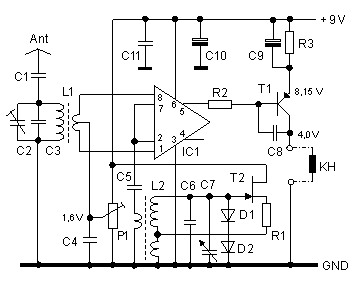
I would be grateful for a professional translation or correction of the following text. Please E-Mail to Delta Lima 2 Yankie Echo Oscar @ Queen Romeo Papa 4 Uniform .Delta Echo
80 m Band Direct Conversion Receiver
The first differential amplifier inside the NE592 is used in this application (unlike it's normal function) as a symmetrical mixer. For mixing purposes the oscillator signal is fed to both emitter terminals (pin 2 and 7) in parallel. Received signals from the CW segment preferably reach the NE592 differential input due to a pre-selection of a 3560 kHz tuned input filter. Identical transistors inside the IC and a symmetrically designed input circuitry lead to a good AM suppression without any further balancing measures. P1 defines the mixer biasing, whereby best sensitivity, AM suppression and audio quality isn't achieved at Ub/2 but at 1,6 V at Ub=9 V).
Fig. 1: Receiver schematic

Variable oscillator VFO
A Hartley oscillator serves as a VFO. It has enough power for driving the mixer. Best sensitivity could be achieved with an oscillator voltage of 100 mVss at pin 2 and 7. With the shown components you'll get a tuning range from 3520 kHz up to 3600 KHz at the beginning of the 80 m band Component tolerance could require minor modification in relation to the frequency relevant components L2/C6.
AF amplifier
The output circuitry offers a special feature that cannot be seen at first glance. T1 together with C8 and the headphone inductance form an AF oscillator or a selective amplifier. This stage has a resonant frequency of around 700 Hz and it signifies that self-oscillation is near. Low frequent mixing products, especially CW signals, are preferably amplified. Supposing this stage is oscillating without having an input signal or it is without sensitivity, you should modify the components that are placed close to T1. Varying the component values could help. The problem with this stage is, that there is nowadays little availability of the headphones (4 kOhm, 2,4 H) needed. Please don't ask me what type of oscillator it is, I can't say what it is, but it works well. For audio power setting an attenuator potentiometer at the antenna input is recommended.
Power supply
I run the receiver at +9 V, whereby the current consumption is 10 mA. Disturbing 50 Hz hum in the middle of the tuning range disappears at once when changing over from the AC based supply to battery supply as a trial. One chokes each was set into the +/- supply leads of my power supply module after this test.
Parts list
| Parts No. | Value |
|---|---|
| P1 | 10 kOhm trimmer potentiometer |
| R1,R3 | 1 kOhm |
| R2 | 1,8 kOhm |
| C1 | 4,7 ... 10 pF |
| C2 | 80 pF trimmer cap |
| C3 | 470 pF |
| C4, C11 | 0,1 uF |
| C5 | 2,2 nF |
| C6 | 330 pF |
| C7 | 2x 20 pF variable capacitor for VHF |
| C8 | 680 pF |
| C9 | 10 uF, 10 V |
| C10 | 100 uF, 16 V |
| L1 | T50-2, 27 t. prim. / 2x 2 t. bifilar sec. |
| L2 | T50-2, 2 x 15 t. bifilar prim. / 1 t. sec. |
| D1, D2 | 1N4148 |
| T1 | 2N3906 |
| T2 | 2N3819 |
| IC1 | NE592 DIP |
| KH | Headphones Ri=4 kOhm , L=2,4 H |
Alignment
For the receiver alignment the existing main-station rig is sufficient. Check the VFO frequency first. Receiver tuning should be possible between 3520 kHz (C7 max.) and 3600 kHz (C7 min.) by means of the variable capacitor. For this, listen to the own VFO signal at the main rig. Finally adjust C2 of the input filter to 3560 kHz, maximum audio power of an operating amateur radio station.
"Comfort Version"
You will get a "comfort version" with only some extra components. A regulated voltage for the oscillator and the NE592 avoids frequency change at drifting Ub. The selective AF amplifier can be switched over from CW to SSB reception. It has enough audio power for driving walkman headphones with a 220 Ohms resistor in series. The left side of this schematic is absolutely identical to the one described before.
Fig. 2: Schematic of the "comfort version"